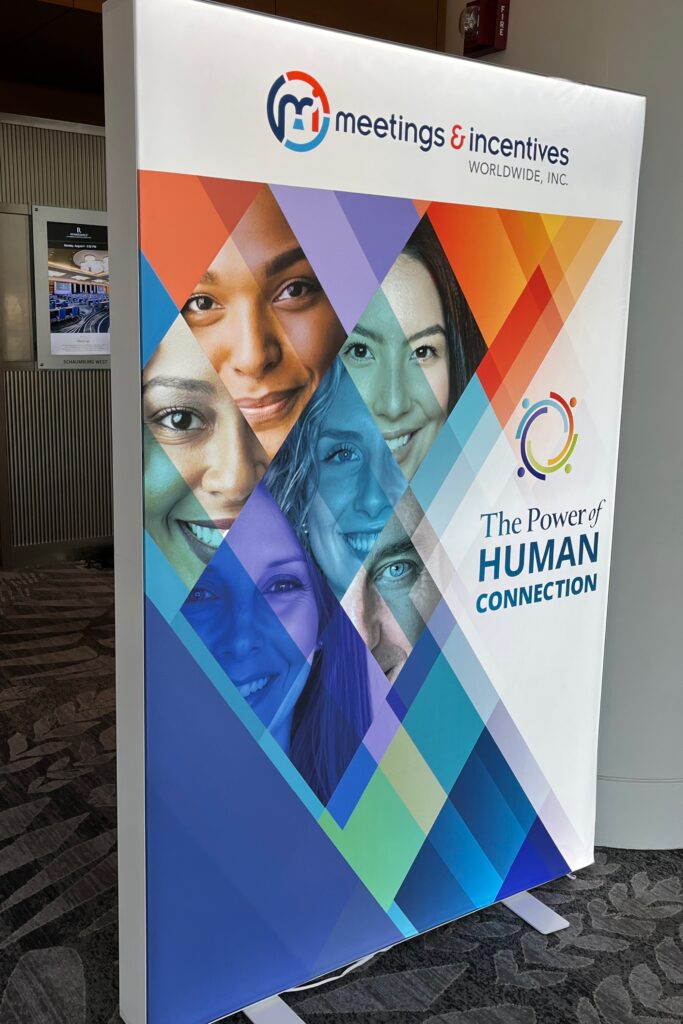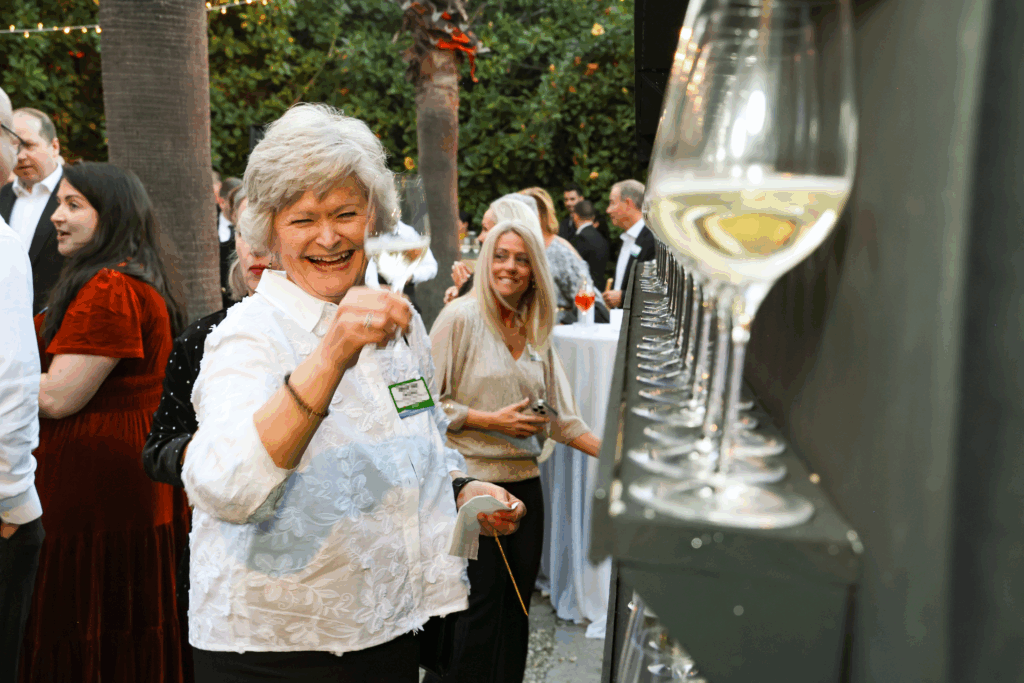Top 10 Takeaways from the M&IW Summit
The 2025 M&IW Summit brought together Meeting & Incentives Worldwide’s community of customers, potential customers, partners, and employees for a dynamic exchange of ideas and valuable industry networking. Centered around the theme The Power of Human Connection, the event explored the latest trends and best practices shaping meetings, events, and incentives.
With so many thought-provoking sessions and actionable insights, our brains were buzzing with new perspectives and inspiration. In this blog, we share our top takeaways to help you elevate your event strategy and create more meaningful experiences.

10 Actionable Insights for Event Leaders
Whether the focus was on elevating attendee engagement, leveraging data for smarter planning, or crafting unforgettable experiences, speakers shared practical strategies and fresh insights that can be applied to programs of all scopes, from large events to executive meetings and beyond. Here are the key takeaways from the 2025 M&IW Summit.
1. AI Should Enhance Human Expertise, Not Replace It
While AI offers powerful capabilities in event planning and management, human connection remains irreplaceable. M&IW’s Chip Begley, Director of Event Technology, and Missy Peterson, Sr. Director of Business Transformation & AI, advocate for balancing AI’s potential with practical considerations and human oversight.
Stay curious, ask better questions, and focus on delivering value when implementing AI. This ensures that technology enhances rather than replaces the core essence of successful events.
“You do not need to overhaul your whole event strategy,” said Missy. “You just need to start small and smart.”
Identify the areas you can use the most help, make the greatest impact on attendees, or can result in the most usable data. “Use AI to polish up some content,” Missy suggested. “Pilot a chatbot for your FAQs. Try segment tracking on one session to see how it reacts in real time.”
And don’t forget, AI has its limitations. Human oversight is still necessary for interpreting data and making strategic decisions based on that data.
Learn More: AI and Event Planning: The New Partnership
2. Data Collection is as Important as Data Analysis
When it comes to informed decision making, the results of your data analysis will only be as strong as the quality of the data behind it. Laura Rog, Lead Business Intelligence Consultant for M&IW’s consulting division, Intent Strategy Group, recommends gathering trusted, structured, and actionable data.
“Ask yourself, what questions are you trying to answer or what behaviors are you trying to influence?” said Laura. “Are you focusing on savings or optimizing team efficiency? Are you trying to drive supplier accountability?”
Collecting data that aligns with your key priorities and addresses your business objectives sets the foundation for impactful and effective decision making. Ensuring the data you capture is relevant and accurate strengthens data integrity and builds the credibility needed to influence change.
Learn More: Executive Dashboards: The First Step to Successful Business Intelligence
3. Effective Event Creative Relies on Four Key Elements
Danielle Omega, Creative Director of M&IW and head of Flow, M&IW’s creative agency, shared that great design goes beyond aesthetics. “It’s about solving problems, enhancing usability, evoking emotion, and communicating clearly to attendees.”
Achieving that level of design relies on four elements:
- Visual Identity: More than a logo, it’s the cohesive look and feel—color palette, typography, iconography, photography—that makes your event instantly recognizable and supports your theme and purpose.
- Environment: This is where creative and event design come together. Staging, lighting, and more influence how people interact, engage, and feel. Branding weaves everything together. It influences the event’s reputation but often goes unnoticed because it’s so well-embedded into the experience.
- Messaging: Consistent messaging is the backbone of creative design. A tone that changes from formal in the invite to casual on the app, for example, creates disconnect. Messaging should provide clarity and confidence. Remember, for event branding, content is king.
- Experiential Treatment: Ask yourself, what will attendees tell their friends about? Design for those moments. Attendees may not remember everything you told them, but they will remember how you made them feel.

Learn More: Creative Services Case Studies
4. Inclusive Design is Non-negotiable for Modern Incentive Programs
Inclusion isn’t new for incentives, but it’s more important than ever. That doesn’t only mean accommodating diverse needs and preferences, although that’s also important. The most effective incentive programs are inclusive of all participant types. If it’s an employee program, for example, that means it’s open to all departments, not just sales.
“Recognition needs to be accessible and meaningful for everyone,” said M&IW’s Marie Ahlers, Customer Success Lead, Incentives & Engagement. “Inclusion ensures everyone feels seen, valued, and motivated.”
While this may be a shift from the typical approach to incentives, it doesn’t require a complete overhaul. The reward can stay the same, but the qualification metrics may need to change.
“We are seeing companies take a more holistic approach to qualification by emphasizing a broader range of performance indicators,” added Ashley Krueger, CITP, Sr. Manager of Incentives & Engagement, M&IW. “The inclusion of customer relationship metrics alongside financial and activity-based measures is more common.”
Learn More: Pros and Cons of Group vs. Individual Incentive Travel

5. Investing in Event Production Increases Your Event ROI
“Event production is roughly one-third of an event budget, and for good reason,” said Lisa Twardowski, M&IW’s Director of Event Experience. It impacts everything and affects both the attendee experience and your event’s returns.
As budgets tighten and return on investment (ROI) becomes more important than ever, you may be surprised to learn than “events with high-caliber production see 30%–50% higher ROI than events with a basic setup,” said Lisa.
Event production also maximizes your return on relationship (ROR), the emotional capital gained through genuine connections.
“Having these memorable moments—whether it’s live entertainment, a truly motivational speaker, or a surprise reveal—creates lasting bonds,” said Lisa. Those bonds increase trust in your brand and lead to recurring participation.
Learn More: Guide to Event Production as a Strategic Asset
6. Smart Menu Planning Saves Money Without Sacrificing Quality
Food prices are up about 20% compared to 2019, with overall food inflation rising about 3% per year. Strategic menu planning delivers significant cost savings without compromising quality.
“Smart menu planning starts with data,” believes M&IW’s Ella Darby, Head of Global Event Experience. “It’s not just about what tastes good. Start with research. Know your attendees, their demographics and preferences, and even cultural considerations like guests coming from countries observing alcohol prohibition or abstention.”
Look at past events as well. Evaluate leftover food and identify items with lower preference. Add questions about menu choices in your post-event survey to start collecting F&B data.
When in doubt, “focus on the classics,” said Ella. “Crowd-pleasing favorites are familiar, satisfying, and budget friendly.”
Learn More: How to Maximize Your Impact Without Maxing Out Your Budget

7. Strategic Booking Reduces the Impact of Air Travel Disruptions
Irregular air travel operations are inevitable, but strategic booking reduces the costs associated with them. Samantha Gehrke, Director of Group Travel at M&IW, shared proactive practices for booking air travel.
- Book nonstop flights to avoid missed connections. If a layover is unavoidable, ensure there’s sufficient time between flights. Just because an airline deems it a “valid connection” doesn’t mean it’s actually realistic.
- For key travelers such as VIPs and speakers, book flexible or refundable ticket fares. In the US, almost all fares are flexible if you avoid basic economy. Internationally, there are several fare levels, but some refundable fares are only a slightly higher cost.
- Choose airlines with reliable performance and irregular operations response. In other words, avoid ultra-low cost airlines. These airlines have limited options, and if there’s a long delay or cancellation, the next available flight could be days away. They also don’t work with other airlines for rebooking.
- When irregular operations occur, stay on the same airline if possible since fees to move to the next available flight are waived.

Learn More: 10 Benefits of Group Air Travel Management
8. Successful SMM Programs are Agile and Data-driven
If you’re beginning your journey into Strategic Meetings Management (SMM), focusing on small wins builds early momentum. Start with identifying stakeholder pain points and strategizing how to overcome those first. This approach builds the trust and confidence of those who will be critical to program adoption.
Begin collecting data early to shape your SMM story by the numbers. This visibility arms stakeholders with the data needed to justify customer and internal in-person events. Maximize the value and impact of your SMMP by defining success metrics early and continuously refining strategies.
“Your roadmap should include flexibility,” recommends Angie Duncan Callaway, Sr. Director of Intent Strategy Group. “Build in time to reflect and reexamine your direction and destination. Needs and demands shift within organizations, so agility is essential.”
“We often recommend a three-year roadmap for program development,” Angie continued. “A data-driven SMMP takes time and effort to build, but the long-term benefits in cost savings, risk management, and improved decision-making are worth the investment.”
Learn More: 5 Benefits of Strategic Meetings Management
9. Travel Authorization Requirements are Changing
M&IW’s Paulomi Debnath and Lynn McCrory Brown, Team Leads for M&IW’s Event Sourcing department, explored the changing global travel requirements. As of January 8, 2025, travelers from 48 countries—including the US—need an Electronic Travel Authorization, or ETA, to enter or transit through the UK. Similarly, Europe’s ETIAS system will launch in 2026.
With these changes, “early registration and proactive communication become essential,” said Lynn. Attendees need to be aware of requirements and deadlines well in advance, so build in longer lead times.
These changes aren’t just a nuisance; they can also benefit your event and bottom line:
- Encouraging longer lead times doesn’t just help with travel compliance. It also gives you access to better venues, stronger pricing, and more meaningful attendee engagement.
- Pre-travel checklists enhance the overall guest experience and reduce the risk of no-shows.
- Because these authorizations require attention early, they encourage early attendee registration, which supports smoother logistics and planning overall.
Learn More: What to Know About Event Sourcing: Part 1 and Part 2
10. Utilize the Three Principles of Neuroscience-based Event Design
Marie Johnson, CMP, Sr. Marketing & Event Strategist at M&IW, explored three foundational principles of neuroscience-based event design:
- Psychological Safety: If attendees feel excluded, overwhelmed, or unsafe, their threat response shuts down curiosity and engagement. Soft spaces with flexible seating arrangements fosters stronger human connections and helps attendees feel at ease.
- Attention Capture and Retention: Attendees can lose up to 70% of newly acquired information within 24 hours. Agenda design maximizes retention by incorporating cognitive breaks, pacing content delivery, and sequencing sessions to sustain attention.
- Emotional Resonance: Emotion is the gateway to memory. Multisensory design using lighting, music, scents, taste, and even texture creates immersive environments that amplify memory and connection. “Emotional bookends”—starting and ending events with inspiring, engaging sessions—also create emotionally charged experiences that make an event more memorable.
Learn More: Neuroscience for Events: Increasing Attendee Engagement & Belonging

Discover the Power of Human Connection with M&IW
Whether you attended Summit or not, whether you can apply all of these learnings or not, one takeaway remains clear: There’s no replacement for the power of human connection.
At M&IW, our belief in that transformative power shapes everything we do. Discover the difference we can make as we work together to elevate your events. Submit an RFP to get started.
Save the Date for the 2026 M&IW Summit
Planning is already underway for the next M&IW Summit. Save the date for July 27–28, 2026! Interested in attending? Click here to join the invite list and receive email updates as more information becomes available.
Interested in sponsoring or exhibiting at the 2026 M&IW Summit? Click here to express your interest.
Related Articles
- Event Emergency Preparedness Planning: Strategic Frameworks for Safer Meetings & Events
- How Global Events Plan Unforgettable Large Events: 4 Ideas to Put Into Action
- The Power of Human Connection: In-person Event Trends
To stay up to date on the latest trends and insights in corporate meetings, events, and incentives, join our mailing list or follow us on LinkedIn.

